Genetics
P-locus
P Locus
P-series, or Pink Eyed locus.
P-series or the pink-eyed locus. This series of alleles control the colour of the eyes, turning black eyes into pink. It also has a strong effect on black and brown pigment, but its effect on the yellow pigment is similar to that of brown dilution's - almost unnoticeable.
1. Full colour P
Full colour gene P is dominant over p and it doesn't matter if there is P/P or P/p.
All black-eyed mouse varieties have this gene. It should also be noticed, that with c-locus pink-eyed varieties (c/c albino, ch/c himalayan, the colour of the eyed is not caused by "p". In fact, these mice often has "P/P".
2. Pink eyed dilution p
This is the only other allele in this locus, which the mouse fanciers normally have. Typical for the pink-eyed dilution p, is the colour of the mouse's eyes. They are almost as light as those of an albino. It also has a quite strong effect on black, brown and blue pigment, but not on red. The over-all effect caused by the pink-eyed dilution is that of a rather warm shade. The black pigment is diluted to light warm dove grey, brown pigment to light warm champagne and blue pigment to a cooler shade (when compared to pink-eyed black) of silver.

"Dove sable", Ay/at B/* C/* D/* p/p |
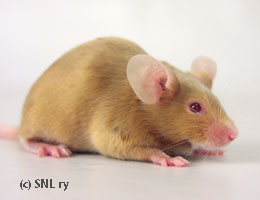
Argente, A/* B/* C/* D/* p/p |
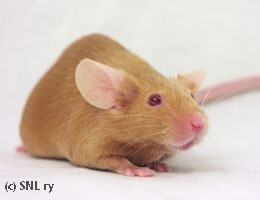
A/* bc/* C/* D/* p/p |
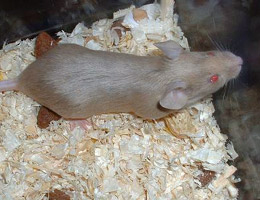
A/* B/* C/* d/d p/p |
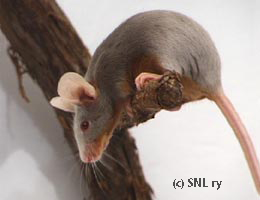
Dove tan, at/at B/* C/* D/* p/p |
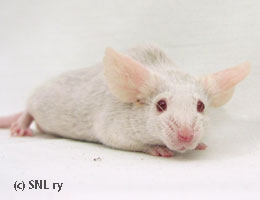
Silver, a/a B/* C/* d/d p/p |
2.1. p with Ay
As mentioned above, the pink-eyed dilution does not have such an effect on red pigment it does on others. Therefore the pink-eyed dilution of Red, Ay... pp, Fawn, is quite alike in colour to Red. However, here different authors hold different views: while some claim that the colour of Fawn is almost identical to that of the Red, or even brighter, other hold the view that this colour should be actually called Orange (as the colour resembles that of a similarly named rabbit colour).? According to one source, this slight lightening in the colour of the pink-eyed "dilution" of red pigment is caused by the dilution of the "background colours" (that causes the sootiness etc).
2.2. p with A
Agouti pink-eyed mice (pink-eyed dilutions of the agouti group colours) superficially resemble red or yellow mice although they have a distinct colour in the base of the hair. The colour of the base is dependent on the other genes present.
A/* B/* D/* p/p, the pink-eyed Agouti, is known as argente (in some US clubs as english gold). The overall effect is a yellowish / pale fawn coat with a silvery blue base. The top colour is "made" of the golden brown layer in the agouti's coat, with the black base being diluted into blueish gray (the standard asks for "the bluer the better"). Black guard hairs are diluted into silvery, which gives sparkling appearance to the coat.
A/* bc/* D/* p/p, the pink-eyed cinnamon, is an unstandardized colour. This has a pale chocolate to champagne undercoat, with the tops being similar to that of the argente. This is said to be very beautiful variety, with the champagne base blending beautifully with the golden top colour. However, for most mouse clubs, it doesn't look different enough from argente, to be standardized.
A/* B/* d/d p/p is the genetic make-up of the pink-eyed dilution of blue agouti. This would make up the following kind of coloration: pale silver base of hair and intermediate yellow top, with silver ticking. This isn't standardized, has a name, nor is described, so this is guessing based on the known effects of p to pigments present in the blue agouti.
A/* bc/* d/d p/p makes pink-eyed dilution of the blue cinnamon. The pink-eyed lilac is what (at least UK) show champagnes are, and the colour is a lighter version of the genetically "correct" champagne. The pink eyed blue cinnamon (or pink eyed lilac agouti to put it another way) would be quite similar to the pink-eyed blue agouti, but slightly softer.
2.3. p with at
Pink-eyed dilutions of the tanned varieties create rather beautiful colours, as the top colour is diluted strongly by the pink-eyed dilution, while the tan belly remains almost the same.
at/* B/* p/p gives us dove tan, genetically pink-eyed black tan. The top colour is reduced to dove grey, with quite strong coloured tan belly. This variety has the strongest belly colour of the pink-eyed tans, being derived from the strongest tanned black eyed variety, the black tan. As the dove top, like the tan belly, does respond to modifiers, the breeder is left to build correct modifiers in order to produce light top with fiery belly.
Note, that in some US standards, "dove" is the name for what I have been calling "lilac" and in these same standards this pink-eyed dilution of black is called "lilac".
at/* bc/* p/p is champagne tan, genetically the pink-eyed chocolate tan. This is the other "strong" tanned variety of the pink-eyed tans. The combination of colours is subtle.
at/* B/* d/d p/p is the Silver tan, the lightest tanned variety of the pink-eyed tans. Due to the diluting effect of blue dilution on the tan belly, this variety isn't that striking. However, there are sometimes rather dark tanned "Silver" tans shown. These are in fact genetically dove tans, which have been selectively bred for lighter top colour.
2.4. p with a
The effects of pink-eyed dilutions on black, chocolate and blue (and the lilac...) is already discussed above, so there isn't actually any need for repeating it all over again. Oh, one note: according to Tony Cooke, the pink-eyed lilac is "paler than either blue or champagne"... Interestingly, this is what show champagnes in Britain are, according to some sources.
Note, that on some genetic backgrounds, a/a B/b p/p mice are lighter than a/a B/B p/p mice.
